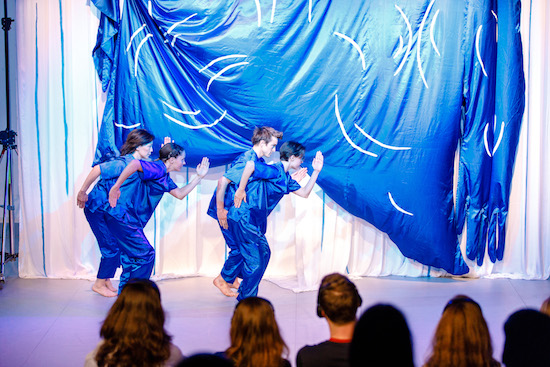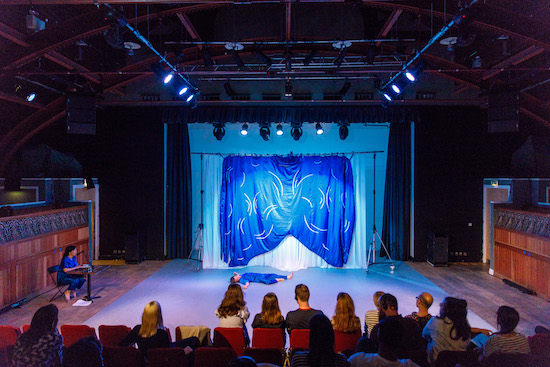At a certain point, quite near the beginning of Stina Nyberg’s performance at Notting Hill’s Tabernacle theatre, the dancers’ movements onstage evoked the logo of the Swedish public health agency. I know this, not because I immediately recognised the pattern, but because a voice whispered the information in my ear as it happened. The voice belonged to dancer Sandra Lolax, one of four performers in Shapes of States, and as the other three – Sindri Runudde, Andrea Svensson, and Nyberg herself – moved in the shape of the distinctive interlocking loops of the Folkhälmsomyndigheten logo, she spoke to me via a set of headphones connected to a small portable device that I and nineteen members of the audience held – but not the other fifty-eight attendees.
Shapes of States unfolded like a noh opera in a series of angular-bodied tableaux drawing imagery and inspiration from the conjoined histories of Taylorism, Meyerholdian biomechanics, and the history of Swedish public health policy around the same period. But at the same time, through a bold formal move, the work constantly draws its audience’s attention to exactly what such ideologies of the strong, thrusting body exclude: the disabled – and specifically, the blind and partially sighted.
We were separated into two groups before we even entered the theatre. The first twenty through the door would be given audio guides with headphones, the rest not. Throughout the performance, members of the troupe provided a whisper a live running commentary of the action – rather like the kind of audio description offered to sight-impaired audiences at otherwise-ocularcentric live events. First Lolax, then the other dancers, Runudde, Nyberg, and Svensson, took turns to tell us what we were seeing, to describe it, explain it, and comment on it.
But what quickly became apparent was the way this commentary was never simply a neutral description of the action on stage. I was reminded more than once of the role of dialogue in the films of Éric Rohmer. Rohmer’s dialogue in films like Ma Nuit Chez Maud or Le Genou de Claire never simply tells you what’s going on. Rather, “what’s going on” emerges in the gaps between what people say and what you can see on the screen. Nyberg’s voiceover, likewise. The dancers would flit from faithfully describing the dance, to commenting on its themes, then to talking about people in the audience, how they themselves feel or what they did yesterday, and moving on to other, often seemingly only tangentially related matters. Some stage action would be elucidated in detail, some not at all. Occasionally, there would be commentary but no action. At all time, our attention is being drawn to the partial nature of this description, to its gaps and excesses.
Drawn as well, of course, to the people for whom such a partial access to a significant swathe of culture is a fact of life. Before seeing Sandra Lolax in this performance, I don’t think I had ever seen a dancer perform wearing glasses. Sindri Runudde, likewise, used his turn at the mic, towards the end of the performance, to reveal that he suffered from a chronic eye condition – and his description inevitably came with the blurred edges of his own degenerating visual field.
“Since Sindri can perform the choreography on equal terms as the other dancers,” Nyberg explained to me via email, “we have chosen not to make it visible for the seeing audience that he has a visual impairment. That he mentions this himself in the visual description is aimed primarily to an audience with visual impairments, to which there is a political point in pointing out his disease for others that are in similar conditions.”

When I asked Nyberg about the work’s title, ‘Shapes of States’, she said, “The title refers to an idea that our physical training (the actual everyday aerobics, gymnastics, yoga, dancing, sports, mindfulness, etc.) do not only reflect society and its ideals, but is part of shaping it. How movements shapes the body as well as the society, or state. Thus, the Shapes of States, refers to means with which we shape society.
“But it also is a hint towards the history of dance training,” she continued, “where we have experienced a shift from modern dance’s stronger focus on “shapes” to more somatic-inspired dance forms focus on “states”. (In other words, how modern dance choreographs the expression of movements through shaping the body into forms, and post-modern dance focus more on choreographing the mind and body into going into different states – which in turn produces expressions). In this performance, we are returning very strongly to working with shapes rather than states.”
Nyberg’s ‘shape’-based movement draws her work close to the biomechanics of Vsevolod Meyerhold. Meyerhold began his career as an actor, working at the Moscow Art Theatre under Constantin Stanislavski around the turn of the century. But as he developed his own style as a director, he distinguished his ‘presentational’ approach from Stanislavski’s ‘representational’ theatre. He asked his actors to develop their characters from the outside in, not by digging up and harnessing their inner emotional states. Influenced by the circus, by the commedia dell’arte, and slapstick, Meyerhold believed in a highly stylised, gestural style of performance. But he was also fascinated by Taylorist industrial production methods, involving the rigid discipline of the working body – or at least, by a certain idea of what Taylorism meant. He sought, in his actors, that they entrain their bodies, in the words of one American visitor to Meyerhold’s theatre in the 1920s, as a “biological machine.”
Around the same time, in Nyberg’s native Sweden, the burgeoning welfare state was developing a sort of biomechanics of its own. The establishment of the new National Institute for Public Health in the 1930s was part of a rash of new legislation designed to encourage the cultivation of a hale and hearty body politic. The emphasis was on the responsibility of every citizen to maintain their physical fitness and psychological wellbeing. Daily exercise was encouraged. Talk of “social hygiene” bandied about. Using the exaggerated gestural language of Meyerhold’s biomechanics, Nyberg’s Shapes of States enacts the not-always harmonious to-and-fro between the state and medicine, the gradual progress of isolated individuals towards union in a single harmonious social machine.

Nyberg detects “a contemporary eagerness and anxiety to trimming the own body to perfection, not only as in physical strength but as in happiness, relaxation, beauty and acceptance.” It is for this reason, she felt, that these entwined narratives of human and political machines possessed a relevance for the contemporary moment. It is, she told me, “as if health is not defined through the lack of disease, but rather as an ongoing project towards something better, different, healthier.”
“Together with the choreographers and dancers Rosalind Goldberg and Sandra Lolax I started working on the issue of what we referred to as the backside of wellness. Whereas we focused on the intimate parts of failure and decay, in Shapes of States I focused more on the relationship between the ideals we train our bodies according to, and the ideals with which we organize our societies. Rather than seeing the same ideals in the early 20th century as I do now, through looking back through history I believe that we can easier reflect on our times. On how our contemporary ideals of what a good or healthy body is are equally conditioned by political ideals, then as well as now. If we practised having a straight spine and a good posture in the 1920’s, today we might be practising flexibility and balance.”
Stina Nyberg, Shapes of States, was at Block Universe, festival of performance arts, on Monday 29 May 2017


